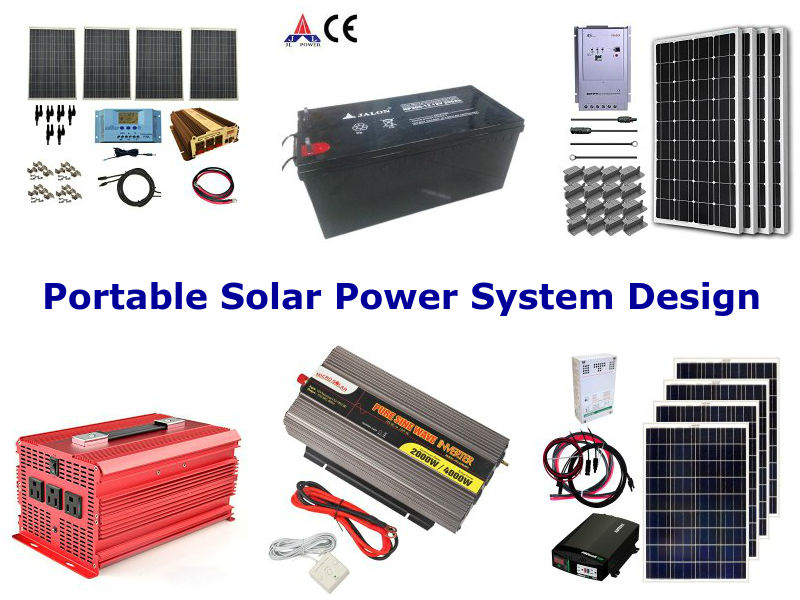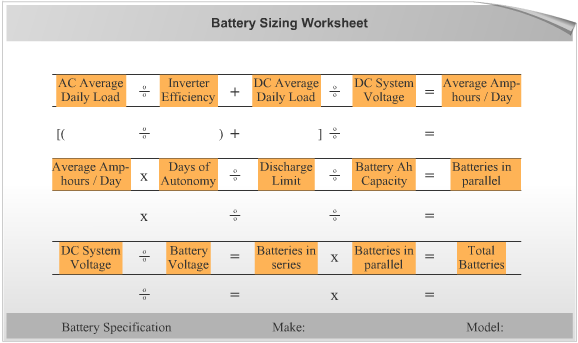At The Long Tail Pipe, we’re all about clean energy stuff and getting into the middle of technology to understand how to improve all our lives. With that in mind the last couple months I’ve been studying how to do solar design, and recently wrote a resource page on designing solar power systems. That page is full of theory, the ampacity of wiring, calculating the solar array size required to supply a given electrical load, the battery pack capacity to provide some days of autonomy, and more. It’s time to take a practical look at building a small solar power system, and the exact components required.
Suppose you’re an artist going to art & wine festivals, and you don’t want a stinky noisy gasoline generator ruining the mood of people looking at your art? Or you’re going to the park with some friends to play some tunes? Or you’re a musical band playing gigs at Green festivals, and want the image of a completely clean power technology driven act? In these and many other cases you need a portable solar powered system for electricity on the go.
In other words, the need is for an off-grid solar power system. While we’ll discuss how to charge the energy storage from the grid, we don’t need to connect this to supply power to the grid.
There are products already on the market, but we’re going to take a look at what’s required to build such a system.

This unit has a 5000 Watt peak, 2500 Watt continuous, inverter, with two 100 Watt solar panels, a 30 amp charge controller, and a regular 120 volt power outlet. The energy storage is packed in a rugged-looking case that’s on wheels, making it feasible to roll around.
The 200 amp-hour battery pack – if it’s at 12 volts – provides 2.4 kiloWatt-hours of energy storage. Since it’s a bad idea to discharge a battery pack too low, the effective capacity is more like 1-1.5 kiloWatt-hours.
[www.amazon.com
This is just an energy storage unit, on wheels, with a 1500 Watt inverter. It has a 51 amp-hour battery, providing 600 Watt-hours capacity, or about 300 Watt-hours effective.
This one does not include solar panels. They could be easily retrofitted by adding a charge controller and some wiring.
[www.amazon.comRugged rolling cargo cases
The first thing that’s needed isn’t anything to do with solar, or energy storage, but a simple practical thing – the rolling case. What we want is a simple rugged box, on wheels, with a handle, letting it be easily rolled around.
Autonomy, energy storage capacity
What we should be doing right now is estimating the energy capacity required (kiloWatt-hours) based on the period of autonomy, or the hours or days of non-solar operation, that’s required. For a specific application, let’s talk about a couple scenarios:
- Powering lights at a booth at an Art & Wine festival: This scenario means about 500 Watts, or so, of electricity consumption for about 3 hours. A lot depends on the total equipment being powered, and the conditions at the site. Maybe some equipment has to be powered for the entire show, and the show organizers don’t want portable solar panels to be erected, and therefore the power requirement is 8 hours or more. Let’s strike a balance and say 400 Watts of energy for 3 hours, or 1.2 kiloWatt-hours of effective energy storage.
- Apartment dweller charging an EV at home with a portable energy storage unit: I have this crazy little need of charging my electric car at home, and being forbidden by the apartment manager from doing so. One option is a portable energy unit that I’d charge inside, then roll out to the car. At a minimum it would need to supply 1.2 kiloWatts of power for 2 hours of charging, therefore requiring 2.5 kiloWatt-hours of effective energy storage.
This is the worksheet used to calculate the battery pack size required for a given time of autonomy. But we’ll have to adapt these formulas a little bit.
We just calculated two scenarios requiring 1.2 kiloWatt-hours and 2.5 kiloWatt-hours of usable energy storage. For a maximum 50% discharge, which is fairly steep and we’d see better pack lifetime at a shallower discharge, the rated energy storage required is 2.5 kiloWatt-hours and 5 kiloWatt-hours respectively.
For a 12 volt DC System Voltage, meaning a 12 volt battery pack, we need 209 Amp-hours and 418 Amp-hours of battery pack respectively. With a 24 volt pack, the Amp-hours required is half that, and for a 48 volt system the Amp-hours required is 1/4th that.

These are 200 Ah 12 volt deep cycle lead-acid batteries. The Exide battery is 15.5 x 13.8 x 10.2 inches and weighs 70 lbs.
Either one or two of these are required for the scenarios named here.
The weight can be reduced by using a nickel-metal-hydride or lithium-ion battery system rather than lead acid. But either choice costs a lot more than these batteries.
[www.amazon.comAcquiring large size lithium-ion battery packs is a specialized purchase at the moment. Where the market for large scale lead-acid battery systems is mature, with over 100 years of history, the equivalent lithium-ion battery pack market is miniscule. Looking on eBay for Nissan Leaf battery modules![]() shows not just modules from Leaf’s (these can be acquired from wrecked cars) but Tesla Model S and other electric cars. A suitable set of Leaf modules comprising a 48 volt 60 amp-hour pack is priced at over $800, and weighs 64 lbs. The lead-acid batteries listed above range from $250-$350 in price.
shows not just modules from Leaf’s (these can be acquired from wrecked cars) but Tesla Model S and other electric cars. A suitable set of Leaf modules comprising a 48 volt 60 amp-hour pack is priced at over $800, and weighs 64 lbs. The lead-acid batteries listed above range from $250-$350 in price.
Given that the weight isn’t that much different (64 lbs versus 70 lbs) it might be better to go with the lead-acid battery for now, due to the cost.
Choosing the inverter
The scenarios we discussed require 120 volt power outlets, meaning we need an inverter to convert the DC voltage from the pack to pure sine wave AC to run the equipment.

At 10*6.5*5.3 inches and 10 lbs weight it’s fairly compact and luggable.
Rated Power: 2000W, Max Power: 2300W, Peak Power: 4600W. Input: DC 12V, Output: AC 110V-120V
[www.amazon.com
At 15.8 x 9.4 x 3.7 inches and 11 lbs weight, it’s a bit larger than the previous one.
12V DC Input, 120V AC Output. Conversion efficiency: 90%
Comes with battery cables and a remote control gizmo.
[www.amazon.comThe 2000 watt inverters are suitable for the electric car charging scenario we named. The art & wine festival scenario can be handled by a smaller capacity inverter.
The first inverter came with “battery clips” and was meant to be connected to a car battery. That’s not the best way to connect a high power inverter to a battery. Instead it’s better to connect thick battery cables with ring terminals clamping them to posts on the battery with a secure stable connection. For convenience there should be a connector so the inverter can be disconnected from the battery.
Both of these inverters have fuses on both input and output sides. It can also be useful to wire in an external fuse, meaning you need a fuse holder![]() , and suitable fuses
, and suitable fuses![]() .
.
Charging off AC power at home
We don’t have a complete working system yet, because there’s no way to charge the battery pack.
While our goal is to charge this with a solar panel, it’s also possible to charge off a 120 volt AC power source.

There are a wide selection of inexpensive 12 volt lead-acid battery chargers meant for charging car batteries.
This one will charge at up to a 12 amp continuous rate. Since the battery we chose is 200 amp-hours it means a 10-20 hour complete recharge time.
Some of these automotive chargers have mode for 50 amps or more at bursts, to help jump-start a car. That feature is not required for this purpose.
[www.amazon.comCharging from Solar
With the 12 volt charger just shown we could declare victory, because we’d have a relatively clean portable power solution. The portable power system would be a battery and an inverter, and we charge the battery at home.
Adding a solar array takes this to the next level. We can potentially charge the system while away from home just by putting up the solar panels, for example, and we’d be 100% certain our electricity is 100% clean. Electricity off the grid is usually generated by burning fossil fuels.
These two worksheets are used to size the solar array, and the charge controller, for an off-grid solar power system.
We have a 200 amp-hour battery pack (or two of them) that we want to charge within one day. By keeping the max discharge to 50% of capacity, we’ll need to recharge 100 amp-hours a day. Therefore
100 amp/hours/day, 80% efficiency, 5 peak sun hours/day = 25 array peak amps
The solar array needs to supply 25 amps (or 50 amps) to recharge this battery in one day.
Going by the second worksheet, the charge controller needs at least 62.5 amps power capacity.

Renogy 100W Monocrystalline Solar Panel Maximum Power: 100W Optimum Operating Voltage (Vmp): 18.9V Optimum Operating Current (Imp): 5.29A
Renogy 40A MPPT Charge Controller (Negative grounded) Rated Charge Current: 40A Max. Solar Input Voltage: 100V DC Max. PV Input Power: 400W (12V), 800W (24V)
At 5.29 amps per module, and 25 amps required, we need 5 modules. Since the kit comes with four modules, an additional module is required, and they are sold separately. The fifth module will require an additional set of mounting brackets.
The MPPT charge controller makes sure power output is as optimal as necessary, and it has enough capacity to handle five modules. The panels should be wired in a series-parallel arrangement to avoid the input voltage going too high. Doing so means buying additional cables for that wiring. Going by the comments on the product page, the wiring supplied with the kit is incomplete and you’ll need some more.
The panels are 47 x 21.3 x 8 inches and weigh 16 lbs. That makes a total system of about 4 feet by 10 feet and about 75 lbs.
A fuse rated for at least (40 x 1.25 x 1.25) 62.5 amps must be wired between the panels and charge controller.
[www.amazon.com
This is a similar kit, from a different manufacturer. It is four panels, a PWM charge controller, and a 2000 Watt inverter.
It’s not quite enough power for the scenarios we specified, and the PWM charge controller is not what is wanted since MPPT controllers optimize the power output.
[www.amazon.com
- The USA should delete Musk from power, Instead of deleting whole agencies as he demands - February 14, 2025
- Elon Musk, fiduciary duties, his six companies PLUS his political activities - February 10, 2025
- Is there enough Grid Capacity for Hydrogen Fuel Cell or Battery Electric cars? - April 23, 2023
- Is Tesla finagling to grab federal NEVI dollars for Supercharger network? - November 15, 2022
- Tesla announces the North American Charging Standard charging connector - November 11, 2022
- Lightning Motorcycles adopts Silicon battery, 5 minute charge time gives 135 miles range - November 9, 2022
- Tesla Autopilot under US Dept of Transportation scrutiny - June 13, 2022
- Spectacular CNG bus fire misrepresented as EV bus fire - April 21, 2022
- Moldova, Ukraine, Georgia, Russia, and the European Energy Crisis - December 21, 2021
- Li-Bridge leading the USA across lithium battery chasm - October 29, 2021

















